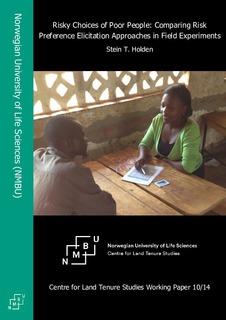| dc.contributor.author | Holden, Stein Terje | |
| dc.coverage.spatial | Malawi | nb_NO |
| dc.date.accessioned | 2018-01-24T13:18:23Z | |
| dc.date.available | 2018-01-24T13:18:23Z | |
| dc.date.issued | 2014 | |
| dc.identifier.uri | http://hdl.handle.net/11250/2479441 | |
| dc.description.abstract | This paper studies the risk preferences of poor rural households in Malawi and compares the Holt and Laury (2002) (HL) multiple price list approach with hypothetical real-world framing and monetary incentive-compatible framing with the Tanaka, Camerer and Nguyen (2010) (TCN) monetary framing approach to elicit prospect theory parameters. The consistency of the results, the role of and potential bias attributable to measurement error, and correlations with socioeconomic characteristics are assessed. The study shows that measurement error can lead to upward bias in risk aversion estimates and over-weighting of low probabilities. The hypothetical real–world HL framing experiments are associated with higher sensitivity to background variation such as exposure to a recent drought shock and distance to markets/poor market access. | nb_NO |
| dc.language.iso | eng | nb_NO |
| dc.publisher | Norwegian University of Life Sciences, Ås | nb_NO |
| dc.relation.ispartofseries | CLTS Working paper;2014:10 | |
| dc.rights | Attribution-NonCommercial-NoDerivatives 4.0 Internasjonal | * |
| dc.rights.uri | http://creativecommons.org/licenses/by-nc-nd/4.0/deed.no | * |
| dc.title | Risky choices of poor people : comparing risk preference elicitation approaches in field experiments | nb_NO |
| dc.type | Working paper | nb_NO |
| dc.subject.keyword | Risk assessment | |
| dc.subject.keyword | Losses | |
| dc.subject.keyword | Field experimentation | |
| dc.subject.keyword | Probability analysis | |
| dc.subject.keyword | Measurement | |

